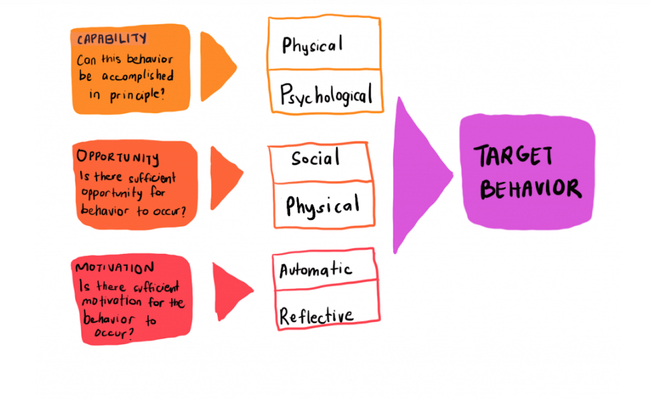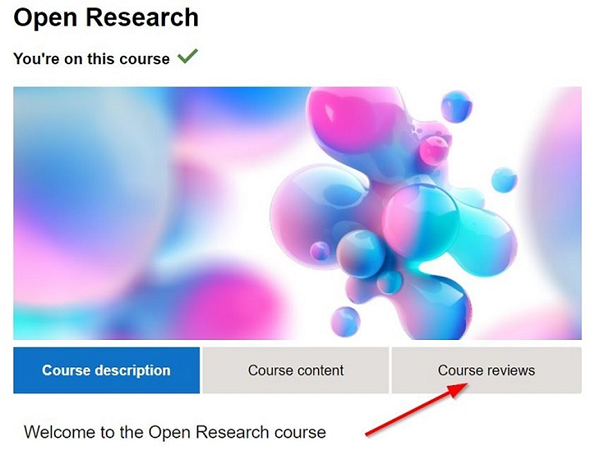Use 'Print preview' to check the number of pages and printer settings.
Print functionality varies between browsers.
Printable page generated Thursday, 27 November 2025, 12:23 PM
Committing to open research
Introduction

In Weeks 1 to 7, you learned about different aspects of transparency, integrity, and accessibility in open research. You discovered why these principles are important, and which open practices you can enact to ensure your own research is more in line with them.
However, you’ve learned less about how exactly to commit to open research and make these practices a part of your research habits and norms. Press ‘Next’ to take this final step!
Behaviour change
Research is behaviour – we do research. Engaging in open research means engaging in a variety of specific behaviours. Some of these behaviours may have even been discouraged in some of the research training you have received, depending on when you did your research training. For this reason, it can be useful to think of engaging in open research as just another behaviour that you can think about changing, like healthy eating or exercising!
The COM-B model proposes that capability, opportunity, and motivation are necessary for behaviour change. The diagram below summarises what the COM-B model says about the conditions that are most likely to lead to effective behaviour change.
In a survey of researchers in psychology departments across the UK and Ireland, researchers found that capability, opportunity, and motivation all affected someone’s likelihood to engage in open research practices (e.g. preregistration, and open data and materials). However, the strongest predictor was automatic motivation – agreement with these statements:
- I have developed the habit of engaging in open research practices as an everyday part of my research process.
- When I think about my research, I automatically think about the open research elements as well.
Activity 1:
Allow about 10 minutes
Think about what you’ve learned in Weeks 1 to 7 of this course. Spend ten minutes writing down your ideas about how you could implement open research as part of your everyday research habits.
Use the note-writing box below to record your ideas.
Open access repositories
One of the things that can make open research difficult to ease into is that there are many different resources, with contradictory or confusing advice on the best ways to engage in different open research practices. It can be onerous to find and navigate the multiple platforms, software packages and systems.
Luckily, the Open Science Framework (OSF) does a lot of this work for us. The OSF is a free, open platform that supports research and enables collaboration. It also provides guides on different aspects of open research. The OSF is not the only way to engage with different open research practices, but since it has functionality that covers several open research practices at once, it can be a good place to start. Some of the ways that you can use the OSF are outlined below.
Projects
OSF projects allows you to plan, collaborate, and organise your research studies. First, you create an OSF account. Then create a project: think of it as a folder for everything to do with one study. You can add collaborators, upload files, and review any additional capabilities that you may or may not want to use (e.g. integration with different software like Google docs or GitHub). Projects can be kept private or made public, so this can be a great way to share your data and materials publicly when they’re ready. Some people find it helpful to add materials as they progress with a study, and others just upload everything when finished.
Preregistration
You can also use the OSF to preregister your studies. Preregistration plans can be of various levels of specificity (from answering a few quick questions to creating extensive documents including analysis plans), and these different levels can all be preregistered on the OSF with a variety of templates for research from different disciplines or methodologies. After you have drafted your preregistration, once you ‘register’ them officially, they get locked and timestamped. You can link your preregistration to your OSF project, which also enables you to include any additional documents related to your project.
Preprints
You can also use the OSF to upload a preprint of your work. As you learned in Week 6, a preprint is an open-access version of your work. A preprint server is the platform that hosts your preprint: it is free to access, both for you, the uploader, and your readers. Preprint servers are usually by research discipline, but can also be organised in other ways, e.g. AfricaArXiv is a preprint server for research done by African researchers across all disciplines. Several preprint servers are hosted through the OSF (including, but not limited to, PsyArXiv, SocArXiv, and SportRxiv). If none of the listed servers represent your work well then you can also upload your preprint under the general ‘OSF preprints’. You can also link the preprint to your OSF project, so readers can easily access other materials related to your project.
In general, the OSF is a great ‘one-stop shop’ for enacting many of the open research practices that you have learned about in this course. By learning how to navigate and use this one platform, you can integrate many open research practices into your research habits. But it is not the only trusted repository – as you learned in Week 2, there are various institutional and discipline repositories. The Open University also has its own research repository for collaborating, planning and organising research projects, called ORDO.
Activity 2:
Allow about an hour
This activity will familiarise you with two open access repositories: ORDO and OSF.
Activity 2.1:
Browse through ORDO and see if you can find a dataset for a project called ‘Building trust in digital policing: A scoping review of community policing apps’ published by an author of this course. How many categories (fields) are included in this project?
When you are ready, press 'reveal' to see our comments.
Discussion
You should have been able to locate the dataset. It was part of a research project which included seven fields of study, and the dataset has been downloaded several hundred times. It is stored on ORDO under a permanent, citable web link.
In the second part of this activity, we turn our attention to the OSF. If you belong to a discipline for which the OSF would not be a natural choice, you can substitute a different repository that is targeted to your discipline.
Activity 2.2:
Make an OSF account (if you don’t already have one), and create a project for one of your research studies. You can keep it private so don’t worry about making it perfect! Go through some of the OSF guides, then upload some documents and organise your project into different components and subfolders.
When you are ready, press 'reveal' to see our comments.
Discussion
You have now set up your own OSF account and created a project. You can choose to make the elements of your project public when you’re ready, or if you are using this as a private practice run, that’s okay too. It’s useful to keep OSF guides nearby while you familiarise yourself with the OSF platform. Keep practicing and if you like, explore other features e.g. adding collaborators (contributors) to projects!
Finding your community
Having access to resources that help you engage in open research practices is a great first step, but navigating your open research journey will be so much easier if you surround yourself with like-minded people who can help each other. Being a part of a community means you have people you can turn to if you have questions: you can learn from each other's mistakes and successes, and maybe even forge collaborations!
Nowhere Lab
Nowhere Lab is an online community that anyone can join that holds weekly Zoom meetings and has an active slack community. It is hosted by the lead author of this course. Although Nowhere Lab is not explicitly focused on open research, open research is a topic that is heavily covered, whether that be through discussion sessions, journal clubs (where members discuss a paper together), or training on different open research practices.
FORRT
The Framework for Open and Reproducible Research Training (FORRT) is a community of educators who wish to integrate open science principles into their teaching. They strive for open and reproducible research training, advancing research transparency, reproducibility, rigour, and ethics through educational reform. FORRT provides educational infrastructure and resources designed to support the teaching and mentoring of open and reproducible science. You can explore their resources directly to learn more about open research, and join their slack community.
Open research across disciplines
Interdisciplinary communities can be great for learning about how open research affects different fields differently. They can also be helpful for finding out how open research is done in your specific field. For this, check out Open Research Across Disciplines – a tool for exploring open research resources and case studies across fields. You can also use this resource to find people working on open research in your field and even reach out to them!
Big team science
Big team science has been mentioned a few times in this course, and it’s worth noting that as well as the benefits for credibility and accessibility of research, big team science can also be a great way of finding and building community. Joining a big team science project in your field can be a great way to learn about open research and get started in some open research practices before applying them to your own research.
Activity 3.1:
Allow about 10 minutes
Use the Open Research Across Disciplines tool to find resources for open research in your field. Spend ten minutes thinking about how you could apply these tools or ideas to your own research habits.
Use the text box below to write your thoughts.
Go back to your notes for Activity 1, where you were asked to write down ideas of how you could implement open research as part of your everyday research habits. Now, think about how you can share your data and materials from a research project you have finished. If you have not finished a project yet, you can use an imaginary one.
Activity 3.2:
Allow about 20 minutes
Use the open research decision tree to look up some possibilities. Click on the link to the open research decision tree, click the Actions button, then the I’ve finished button. This will take you to about ten possible actions you could take. What are they? Not all of these actions may be appropriate or achievable in your particular project – that’s fine! Once you have lined up some possible courses of action, you can choose the ones that are most practicable.
Use the text box to record what you find.
The buffet of open research

Throughout this course, you have discovered a number of tools you can use to make your research more open. However, not all of them will be practicable for every project. What you can do may depend on the details of your research, or on broader considerations such as the amount of your funding, your career stage, and the level of support your institution offers.
You might want to think about approaching open research like a buffet:
‘You might not be able to try everything’ – not all open research methods are appropriate for every research study (and you might not like every dish at the buffet).
‘You don’t have to try everything all at once’ – incorporating even some open research methods in your work is a step forward, and trying to do too much might be overwhelming (much like eating too many dishes from the buffet).
‘Label everything’ – as you have learned, documenting the research process is important for transparency and helps other researchers understand the steps taken (just as having food properly labelled prevents people accidentally eating something they shouldn’t).
There is not one correct way of doing open research – we can take whatever we like from the ‘buffet of open science’.
Getting more from this course
You are nearly at the end of the course. After you have completed the next couple of sections, you should be ready to receive your digital badge and certificate of completion. However, this does require you to have read all the material in the course, so now is a good time to go back and make sure you have read every page and attempted every question.
At the end of the course, you can download the notes you have made and take them away with you. You do this by clicking 'Download your answers for the documents on this course', as shown in the illustration below. This will generate a .pdf file that you can keep.

Even after the course is finished, you will still be able to refer back to the main text whenever you want. You will still be able to benefit from the links and additional reading in the references sections.
The interactive decision tree will still be at your disposal. It has been built to support your learning during the course, but once you finish the course, you will find it invaluable. It will help you reach the information you want to find quickly. The decision tree has also been developed with independent researchers in mind, so they can benefit from the information it contains, without necessarily doing this course. As such, you can share the open research decision tree freely using the link above.
We would love to hear your experience of this course. If you would like to leave a review, you can do so by going to ‘Course reviews’ on the course home page as shown below.
Quiz

Congratulations! You’ve reached the final quiz. This final quiz has been designed to help you make the transition from doing the course to applying what you have learned in your own practice. It draws on ideas you have learned earlier in the course. As with all the quizzes so far, it is more important to think through your responses, and read the feedback, than it is to get every answer correct first time.
How well have you understood open research?
Summary
Congratulations – you’ve reached the end of the final week of the course! This week, you explored how to incorporate open research into your research routine by using the support and resources that are out there, and discovering your own open research community.
Over this whole open research course, you’ve learned about why transparency, credibility, and accessibility are so important in open research, and how to apply these values to your own research. You have explored some of the actions that you can take in order to ensure your research complies with these. You have developed skills in key processes of open research, such as replication, preregistration, transparent writing, robustness analysis and open publishing.
We hope you have enjoyed the course, and that you will continue enjoy taking what you have learned here into the wider world of open research.
References
Center for Open Science (2024): OSF Preprints
Available at: https://osf.io/ preprints
Farran, E. K., Silverstein, P., Ameen, A. A., Misheva, I., Gilmore, C. Open Research: examples of good practice and resources across disciplines
Available at: https://osf.io/ preprints/ osf/ 3r8hb
Kathawalla, U., Silverstone, P., Syed, M, (2021): Easing into open science: a guide for graduate students and their advisors, University of California Press
Available at: https://bpspsychub.onlinelibrary.wiley.com/ doi/ pdf/ 10.1111/ bjop.12700
Silverstein, P, Pennington, C, Branney, P, O’Connor, D, Lawlor, E, O’Brien, E, Lynott, D (2024): A registered report survey of open research practices in psychology departments in the UK an d Ireland, British Journal of Psychology; 115: 497-534
Available at: https://bpspsychub.onlinelibrary.wiley.com/ doi/ pdf/ 10.1111/ bjop.12700
Silverstein, P (2024): Nowhere lab
Available at: http://nowherelab.com/
The Open University (2024): Open Research Data Online (ORDO)
Available at: https://ordo.open.ac.uk/
The Framework for Open and Reproducible Research Training (FORTT)
Available at: https://forrt.org/
UbuntuNet Alliance (2024): AfricArxiv
Available at: https://info.africarxiv.org/
UK Reproducibility Network (2024): Open research across disciplines
Available at: https://www.ukrn.org/
Return to the course home page
Glossary
- Preprint
- An open-access version of your work (either before, after, or instead of publication in a journal) hosted on a preprint server.
- Slack community
- A slack community is a simple discussion forum, with different channels helping to organise separate conversations for specific subgroups.

